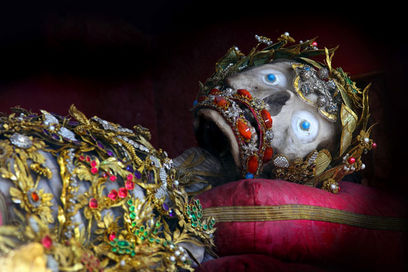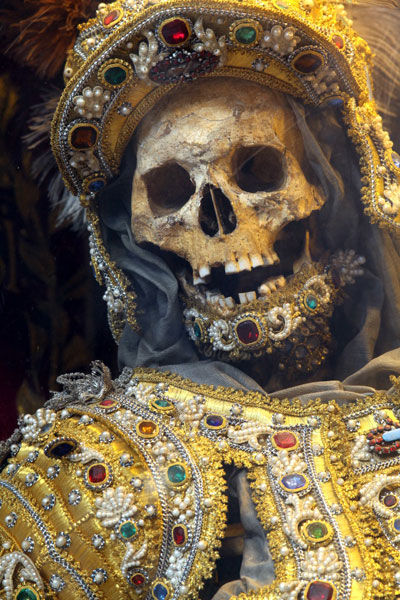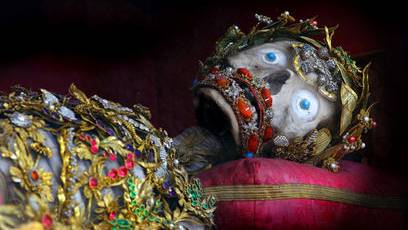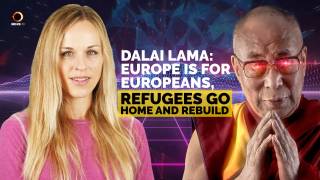Bones with Bling: The amazing jewelled skeletons of Europe
Source: forteantimes.com
A pair of American tourists pause in surprise in the centre of the nave of the Church of Sts Peter and Paul in the small, rural Bavarian town of Rott-am-Inn. Their attention is fixed on a pair of beautifully jewelled, articulated skeletons in niches on the walls of the church, where one might normally expect to find side altars. Reposing inside glass cases, the bones are covered in a finely filigreed costume of golden leaves and precious stones, and jewels mark their mouths and eyes.“Who are they?” one of the visitors inquires.
“I’m not sure about one of them,” their local guide explains, “but the other is Constantine the Great.”
“Constantine? The Roman Emperor?” asks the visitor, now visibly puzzled. “It seems… well, very unlikely that his skeleton would be in this church.”
“Well, this is what I’ve been told,” the guide sheepishly replies.
The identification of the skeleton in Rott-am-Inn as the Emperor Constantine is dubious, but he is only one of several such skeletons, usually found in small parochial churches in Germany and Switzerland, fully articulated and covered over with gold, silver, and gems. They represent a curious and largely forgotten piece of Catholic history from a time when clairvoyant priests would use their powers to ascertain the remains of saints and martyrs.

St Clemens, Church of Sts Peter and Paul, Rott-am-Inn, Germany
PYSCHIC POPES
The trend for jewelled skeletons began in the late 16th century. The Roman catacombs, which had been abandoned as burial sites and largely forgotten about, were rediscovered in 1578 by vineyard workers. This coincided with the initial phase of the Counter-Reformation; the Council of Trent, called to formulate the Catholic response to the Protestant Reformation, had just concluded, and one of the areas of concern was affirming the efficacy and belief in relics against attacks by their detractors. Since the remains in the catacombs dated from the second to fifth centuries AD, it was possible, with a bit of wishful thinking, for Church leaders to romanticise the bones as belonging to almost any famed early Christian saint or martyr. In the newfound cache they saw a potential tool to bolster their supply of relics and promote their power.
In reality, the bones could have belonged to anyone, since very few were provided with specific, identifying information – skeletons from the catacombs could, in fact, be pagan as easily as Christian. Papal secretaries were assigned to authenticate any potential relics, and the requirements were lax – frequently it was necessary only to find a palm on a coffin, or a bit of dried blood. Either was considered a sufficient emblem of a Christian martyr. More problematic was the issue of determining individual identities for the presumed holy personages. For that, a higher power was needed – psychic communion, involving clerical mediums who would descend into the catacombs and ascertain the identities of the skeletons. The practice continued until the mid-19th century, sometimes even involving the Pope himself, if he too had clairvoyant abilities.

Holy Martyr Theodosius, Waldsassen

Relics of St Pancratius, Church of St Nicholas, Wil
Catholic chroniclers were somewhat loath to give specifics about the process of psychically communing with bones, but SI Mahoney, a former Catholic priest who later defected from the Church, left an 1836 account detailing the process. To augment the supply of relics, he explained, trips were periodically made to the catacombs, but no one had a clue as to the identity of the skeletons found there, or if they were even Christian. Thus, Mahoney recalls, Pope Gregory XVI would descend into the subterranean passages accompanied by a group of priests, invoke the Holy Ghost, and read a prayer, “by which Divine assistance, and directions from on high, is sought for the performance of this… solemn duty. The Pope then casts his eyes around the confused mass of mouldering skeletons, and, as the whim may take him, calls this the body of saint such-a-one, another, the body of ‘Virgin some-other-one’ – and so on, till he is warned by his attendants that enough are now baptized… to serve for the present occasion. The rotten bones are then carefully collected, and, having been sprinkled with holy water, are placed in a chest prepared for that purpose, and carried in procession to the Vatican.”[1]
BONEY DOPPELGANGERS
One problem with this method was that it often resulted in rather far-fetched identities. Constantine the Great, for example, died near the Gulf of Izmir in Turkey, and was buried in Constantinople – which makes it preposterous to identify him as a body from the Roman Catacombs. There was also the awkward issue of skeletons being divined as the relics of someone whose bones were already known to be in the possession of the Church. The Church of St Nicholas in Wil, Switzerland, for example, possesses the striking armoured and jewelled skeleton of the third-century martyr St Pancratius, taken from the catacombs in the 17th century. The relics of Pancratius, however, were already claimed to be housed in Rome, in a basilica that bore his name.[2] Nonetheless, Pope Clement X and his staff confirmed the identity of the second skeleton as also being Pancratius, and it was shipped north without any comment about the inconsistency.
[...]
Read the full article at: forteantimes.com
All Images: Paul Koudounaris






















